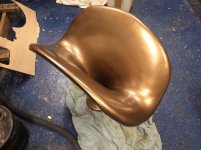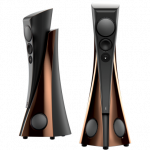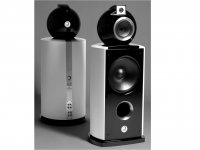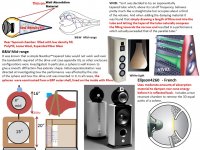Hey all,
I've been looking into building myself a pair of speakers for a while, and possibly building a pair for my family as a gift. I'm eyeing a pair of bookshelf speakers I can put fairly close to a wall in a small room; I've found a couple designs that would work perfectly for me. Paul Carmody's Speedster looks amazing, and at a lower price point Ben Shaffer's Stance is pretty cool.
However, I'm the lead instructor for the Shopbot CNC Router at my university, and I just got a bunch of really nice 3/4" baltic birch for free. So, my question to you all- What's the craziest cabinet design you can think of? General parameters are still the same- Speakers are for a small room, and my budget for drivers/crossovers is around $200-$250. Otherwise, nothing is out of question- I can cut nearly anything with our CNC router, and have a ton of material. What should I make?
If you're just trying to show off the CNC router, I'd build something like a labhorn.
I'm kinda infamous for unnecessarily complex designs, and I gotta tell ya, simple elegant designs are more impressive.
Davone and Estelon speakers are mostly pretty with non-box shape. But not stupidly complex..
An externally hosted image should be here but it was not working when we last tested it.
An externally hosted image should be here but it was not working when we last tested it.
Some funky designs in the Davone catalog, some that might even be DIY-able, but the Estelon Extremes - gorgeous in their own way - a different story I think.EXTREME - Estelon
If I read the dimensions spec correctly, the upper/front module containing the midwoofer, midrange and tweeter can be adjusted in height by 300mm, and total weight per speaker is 250kg. I’d love to see a production video on these, and would be mildly curious as to exactly which Amex card would be required for these “cost no object” sculptures. I’m guessing they’re delivered in a pair of RR Cullinans.
If I read the dimensions spec correctly, the upper/front module containing the midwoofer, midrange and tweeter can be adjusted in height by 300mm, and total weight per speaker is 250kg. I’d love to see a production video on these, and would be mildly curious as to exactly which Amex card would be required for these “cost no object” sculptures. I’m guessing they’re delivered in a pair of RR Cullinans.
Attachments
Actually, I must say now that I have been thinking about cloning the latest Gradient 1.4
The ball could be made of a pair of IKEA Blanda Matt ¤28cm bowls and the stand from a casting tube from Biltema, cut longitudinally and spread open with a blank of wood. I have SEAS coaxials and SB woofers waiting for this already...
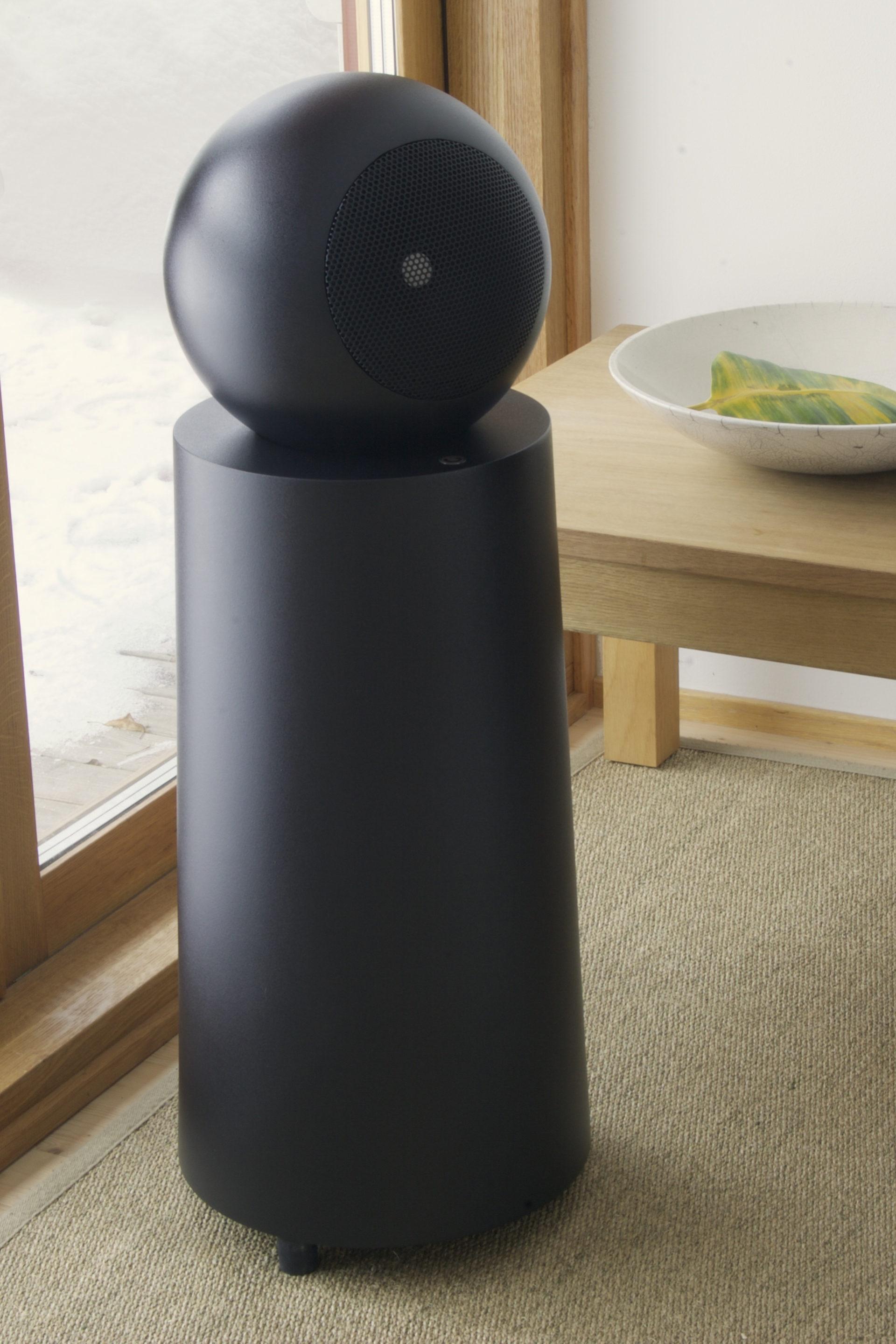
The last baby of great Jorma Salmi Gradient Labs Oy
The ball could be made of a pair of IKEA Blanda Matt ¤28cm bowls and the stand from a casting tube from Biltema, cut longitudinally and spread open with a blank of wood. I have SEAS coaxials and SB woofers waiting for this already...

The last baby of great Jorma Salmi Gradient Labs Oy
Actually, I must say now that I have been thinking about cloning the latest Gradient 1.4
The curved edge of the cylinder in front of the sphere looks a bit doubtful. An improved version with a radiused edge perhaps or would that not look clean enough?
The blurb says he retired a few years ago and his son took over?The last baby of great Jorma Salmi Gradient Labs Oy
Jorma just passed away recently. His son Atte is in the lead now, but Jorma was still active when 1.4 was designed.
Gradient 1.4 loudspeaker, Jorma Salmi | Inner Magazines
Gradient 1.4 loudspeaker, Jorma Salmi | Inner Magazines
Elipson4260 - FrenchActually, I have been thinking about cloning the latest Gradient 1.4.
Uses moderate amounts of absorption material to dampen rear cone energy before it is reflected back. Includes a rear resonant chamber to remove the 3D equal paths of a sphere.
B&W adds a rear tapered tube to reduce resonances.
Attachments
Gradient 1.4's ball has an opening on the backside and it is said to have cardioid dispersion. I haven't seen it opened but it must be something like Elipson with open back and heavy stuffing. If mine will be sealed, a cone against the magnet might be enough. WM xo around 200Hz.
Threads of IKEA bowl speakers, nothing new actually!
Ikea spherical speakers, first build done.
calculations for spherical enclosure.
Great Balls of Prestige
Spherical Enclosure Considerations
IKEA Wooden Bowls
Spheres
Ikea Omni Bowl Speakers
Sphere enclosure: Rounding magnet rear?
Techniques and Materials for Spheres and Ovoids
Speakers constructed using unusual items
Threads of IKEA bowl speakers, nothing new actually!
Ikea spherical speakers, first build done.
calculations for spherical enclosure.
Great Balls of Prestige
Spherical Enclosure Considerations
IKEA Wooden Bowls
Spheres
Ikea Omni Bowl Speakers
Sphere enclosure: Rounding magnet rear?
Techniques and Materials for Spheres and Ovoids
Speakers constructed using unusual items
Illustration of the translaminate construction of the TAD Model 1:
Speaker Design: Driver-Induced Vibrations | audioXpress
Speaker Design: Driver-Induced Vibrations | audioXpress
Yuhazi: I am doing something similar with A teardrop shape aluminum enclosure for the seas coaxial (4.5 inch). I am now playing around with extensional damping, mass damping, modal damping and modification of the modal structures. I will also try constrained layer damping.
Controlling vibrations is a fun game. But what exactly am I aiming for. I will try reducing and taming all cabinet vibrations as best as possible, keeping them below audibility and taking into consideration psycho acoustic phenomena. However I am open to skinning the cat in many ways but using the same overall shape/enclosure. I will experiment. For example the following is one path I will go down:
Since we are talking about a 2 way design I assume one cabinet for bass and mid-range frequencies. I will be using a coaxial to keep things simple.
I am playing with the thin walled approach with damping control so I have to decide at what frequency cabinet resonance will manifest(I can push them down or up by way of geometry and wall thickness and also mass- but I would rather add mass only if I need to). Adding mass to maintain resonant frequency low when adding extensional damping since most likely extensional damping will increase stiffness.
In one implementation I have already lowered the resonant frequency of the first modes below the critical frequencies of 300, the mid-range sounds amazing.
But Now I have to control resonance between 60 and 300 hz using damping or damping techniques, also mass I believe can be used here for damping. Should I try getting the the first mode below 60hz ? I probably will have to research more on mode density to get a better understanding of what is going on.
I am trying to understand how brands/speakers like KISO hb1, Kotaro Micropure, Ocellia, Takamine, Russel K, Harberth etc. speakers control vibrations. They get good reviews so something they are doing is working for them and worth trying to understand and experiment with. I assume psychoacoustic phenomena is important to keep in mind. There are some differences between the mentioned brands but many similarities. Light cabinets that breath with the music.
Maybe they are controlling modal structures. (some tune parts of the cab to resonante at different frequencies - Ocellia and Kiso). This is evident on tap testing. this is also happening somewhat with Harberth cabs I assume since each panel is isolated from the other (this is done to reduce resonant frequency but maybe also distributes amplitude of modal structures in a more even way). (maybe one solid cab would have one big first modal structure where isolating different parts of the cab reduces modal structure size and therefore cabinet panel resonant amplitude and possibly sound at the listener position).
I am not savvy with regards to modal physics. I am reading up on instrument making to better understand the physics. However I am not sure If you can tune a cabinet to resonante evenly at varying frequencies and by doing this control vibration amplitude throughout this frequency band and thereby not allow strong amplitude vibrations at any one specific mode/frequency. I guess maintaining similar Qs. Is this possible? Is this beneficial?
If you are dealing with one strong resonance you would have to damp it so much so that even if you get it below audibility it still can hamper performance by affecting overall cabinet construction (over damping cabinet ) and sound. I guess the opposite would be a tuning fork or bell shape where all the structure resonantes strongly at one modal frequency and not efficiently at others. Any one can clarify whats going on or have any other ideas? Maybe the bell idea is the way to go if you can get it to resonate strongly below the pass band (say 40 hz if your speaker starts at 50hz). Then maybe the other modes will be easier to tame without much damping. Dont really know just supposing, any ideas?
All of the above mentioned brands speak of how the cabinets breath with the music, start and stop quickly with the music signal. This I believe is critical damping, usually you would need a high loss factor/damping factor for critical damping to take place. However it seems to me that some of the mentioned speakers have loss factors in the .06 range (not much damping at all). So I imagine their resonant cabinets are underdamped. Now where does this come into play? above the resonant frequencies? or at the resonant frequencies, or both?
Maybe they can get away with this since they have even amplitude resonance structures? Maybe the combination of controlled amplitude by way of cab construction (tuned cabinet walls, bracing at specific areas) at the desired resonant frequency band (lets say 60 to 450 hz) and underdamped light panels (2.5mm sitka pine as an example) at said frequencies is their secret (so called tuning of the speaker). Many reviewers say that these speakers open up and are really amazing at higher sound pressure levels probably because this puts into motion more of the speaker cabinet and thereby opening up the sound. And I assume this effect is caused by the upper bass frequencies.
I hope this makes sense. Definitely worth playing around with and comparing to other cab designs with greater damping. Side by side comparison would be interesting. And varying degree of cabinet damping and cabinet breathing. .
Assuming you do have high amplitude resonance at certain frequencies and these do contribute to overall sound at the far field (there are always the possibility of cancellations in modal structures.. etc). Maybe there are other ways to control high amplitude resonance without overdamping the rest of the cabinet at the resonant frequencies between say 60 to 300hz. This way you wont have to resort to special cabinet geometry. One example would be using CLD braces (Russel K speaker with simple bracing at strategic location). Remember you want to maintain thin light walls that breath in this implementation.
When said underdamped vibrating cabinet walls are resonating I assume they color sound in a specific way (sitka spruce resonates mainly at its fundamental, but also at overtones, when it is forced to vibrate). Maybe this influences perceived sound also (positively or negatively I dont know). This has to be taken into consideration when playing around with different materials.
Maybe further up on the frequency scale the light panels (not being so mass damped, have some other attributes. Maybe mass damping is more gradual (i read somewhere that by doubling cabinet panel weight mass damping increases at 6db an octave), Less weight of cabinet wall sound transmitting loss is more gradual up to the higher frequencies.
Also cabinet room interactions should be considered. Maybe since the cabinet panels are contributing more to the overall sound than conventional loudspeakers they might energize the room in a specific way. Linkwitz style of sending some of the signal to the back wall so it arrives at different times at the listening position thereby affecting psycho acoustic phenomena. Maybe the side walls produce dipole patterns of sound radiation at certain frequencies. Creating some sort of directivity. Any ideas? Maybe this should be on posted on another thread.
Controlling vibrations is a fun game. But what exactly am I aiming for. I will try reducing and taming all cabinet vibrations as best as possible, keeping them below audibility and taking into consideration psycho acoustic phenomena. However I am open to skinning the cat in many ways but using the same overall shape/enclosure. I will experiment. For example the following is one path I will go down:
Since we are talking about a 2 way design I assume one cabinet for bass and mid-range frequencies. I will be using a coaxial to keep things simple.
I am playing with the thin walled approach with damping control so I have to decide at what frequency cabinet resonance will manifest(I can push them down or up by way of geometry and wall thickness and also mass- but I would rather add mass only if I need to). Adding mass to maintain resonant frequency low when adding extensional damping since most likely extensional damping will increase stiffness.
In one implementation I have already lowered the resonant frequency of the first modes below the critical frequencies of 300, the mid-range sounds amazing.
But Now I have to control resonance between 60 and 300 hz using damping or damping techniques, also mass I believe can be used here for damping. Should I try getting the the first mode below 60hz ? I probably will have to research more on mode density to get a better understanding of what is going on.
I am trying to understand how brands/speakers like KISO hb1, Kotaro Micropure, Ocellia, Takamine, Russel K, Harberth etc. speakers control vibrations. They get good reviews so something they are doing is working for them and worth trying to understand and experiment with. I assume psychoacoustic phenomena is important to keep in mind. There are some differences between the mentioned brands but many similarities. Light cabinets that breath with the music.
Maybe they are controlling modal structures. (some tune parts of the cab to resonante at different frequencies - Ocellia and Kiso). This is evident on tap testing. this is also happening somewhat with Harberth cabs I assume since each panel is isolated from the other (this is done to reduce resonant frequency but maybe also distributes amplitude of modal structures in a more even way). (maybe one solid cab would have one big first modal structure where isolating different parts of the cab reduces modal structure size and therefore cabinet panel resonant amplitude and possibly sound at the listener position).
I am not savvy with regards to modal physics. I am reading up on instrument making to better understand the physics. However I am not sure If you can tune a cabinet to resonante evenly at varying frequencies and by doing this control vibration amplitude throughout this frequency band and thereby not allow strong amplitude vibrations at any one specific mode/frequency. I guess maintaining similar Qs. Is this possible? Is this beneficial?
If you are dealing with one strong resonance you would have to damp it so much so that even if you get it below audibility it still can hamper performance by affecting overall cabinet construction (over damping cabinet ) and sound. I guess the opposite would be a tuning fork or bell shape where all the structure resonantes strongly at one modal frequency and not efficiently at others. Any one can clarify whats going on or have any other ideas? Maybe the bell idea is the way to go if you can get it to resonate strongly below the pass band (say 40 hz if your speaker starts at 50hz). Then maybe the other modes will be easier to tame without much damping. Dont really know just supposing, any ideas?
All of the above mentioned brands speak of how the cabinets breath with the music, start and stop quickly with the music signal. This I believe is critical damping, usually you would need a high loss factor/damping factor for critical damping to take place. However it seems to me that some of the mentioned speakers have loss factors in the .06 range (not much damping at all). So I imagine their resonant cabinets are underdamped. Now where does this come into play? above the resonant frequencies? or at the resonant frequencies, or both?
Maybe they can get away with this since they have even amplitude resonance structures? Maybe the combination of controlled amplitude by way of cab construction (tuned cabinet walls, bracing at specific areas) at the desired resonant frequency band (lets say 60 to 450 hz) and underdamped light panels (2.5mm sitka pine as an example) at said frequencies is their secret (so called tuning of the speaker). Many reviewers say that these speakers open up and are really amazing at higher sound pressure levels probably because this puts into motion more of the speaker cabinet and thereby opening up the sound. And I assume this effect is caused by the upper bass frequencies.
I hope this makes sense. Definitely worth playing around with and comparing to other cab designs with greater damping. Side by side comparison would be interesting. And varying degree of cabinet damping and cabinet breathing. .
Assuming you do have high amplitude resonance at certain frequencies and these do contribute to overall sound at the far field (there are always the possibility of cancellations in modal structures.. etc). Maybe there are other ways to control high amplitude resonance without overdamping the rest of the cabinet at the resonant frequencies between say 60 to 300hz. This way you wont have to resort to special cabinet geometry. One example would be using CLD braces (Russel K speaker with simple bracing at strategic location). Remember you want to maintain thin light walls that breath in this implementation.
When said underdamped vibrating cabinet walls are resonating I assume they color sound in a specific way (sitka spruce resonates mainly at its fundamental, but also at overtones, when it is forced to vibrate). Maybe this influences perceived sound also (positively or negatively I dont know). This has to be taken into consideration when playing around with different materials.
Maybe further up on the frequency scale the light panels (not being so mass damped, have some other attributes. Maybe mass damping is more gradual (i read somewhere that by doubling cabinet panel weight mass damping increases at 6db an octave), Less weight of cabinet wall sound transmitting loss is more gradual up to the higher frequencies.
Also cabinet room interactions should be considered. Maybe since the cabinet panels are contributing more to the overall sound than conventional loudspeakers they might energize the room in a specific way. Linkwitz style of sending some of the signal to the back wall so it arrives at different times at the listening position thereby affecting psycho acoustic phenomena. Maybe the side walls produce dipole patterns of sound radiation at certain frequencies. Creating some sort of directivity. Any ideas? Maybe this should be on posted on another thread.
^Nice idea, but maybe a bit too high mountain to climb? basically, I hate the concept of 2-way speaker. Reproducing frequencies 30-2000Hz means six octaves, and there are too many mechanical and acoustic challenges and interactions. Spilt it for two 3-octave cabinets/drivers and difficulties drop to a cubic root!
In LineSource's post there are ideas behind B&W raindrop shaped cabinets, very nice idea, even better if it was ellipsoid instead of round.
I have now made and measured the IKEA ball and when sealed without stuffing, it has huge interference around 900Hz.
Shared album - Juha Sirkka - Google Photos
In LineSource's post there are ideas behind B&W raindrop shaped cabinets, very nice idea, even better if it was ellipsoid instead of round.
I have now made and measured the IKEA ball and when sealed without stuffing, it has huge interference around 900Hz.
Shared album - Juha Sirkka - Google Photos
Last edited:
- Status
- Not open for further replies.
- Home
- Loudspeakers
- Multi-Way
- Stupidly Complex Cabinets
